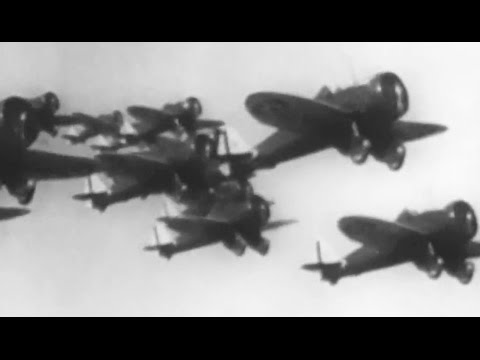US Air Force History playlist:
Aircraft playlist:
more at
“HIGHLIGHTS OF AIR FORCE HISTORY BETWEEN 1931 AND 1941. COVERS HUMANITARIAN FUNCTIONS, INCREASING GERMAN BELLIGERANCE, TECHNICAL ACHIEVEMENTS SUCH AS THE ARNOLD FLIGHT TO ALASKA AND THE DEVELOPMENT OF NEW AIRCRAFT INCLUDING THE B-17.”
Reupload of a previously uploaded film with improved video & sound.
Public domain film from the US National Archives, slightly cropped to remove uneven edges, with the aspect ratio corrected, and one-pass brightness-contrast-color correction & mild video noise reduction applied.
The soundtrack was also processed with volume normalization, noise reduction, clipping reduction, and/or equalization (the resulting sound, though not perfect, is far less noisy than the original).
The American Boeing P-26 Peashooter, was the first all-metal production fighter aircraft and the first pursuit monoplane used by the United States Army Air Corps. The prototype first flew in 1932, and were used by the Air Corps as late as 1941 in the Philippines…
The Boeing-funded project to produce the Boeing Model 248 began in September 1931, with the Army Air Corps supplying engines and instruments. The design—which included an open cockpit, fixed landing gear and externally braced wings—was the last such design procured by the USAAC as a fighter aircraft. The Model 248 had a high landing speed, which caused a number of accidents; to remedy this, flaps were fitted to reduce the landing speed. The Army Air Corps contracted for three prototypes, designated XP-936, with the first flight on 20 March 1932.
The Boeing XP-936 was still tricky to land, however; occasionally, it would flip forward, and because of the short nose it tended to roll onto its back, injuring a number of pilots. The prototype’s unarmored headrest offered virtually no protection in such instances; as a result, production Model 266s (P-26As) had a taller, armored headrest fitted.
Two aircraft were completed as P-26Bs with a fuel-injected Pratt & Whitney R-1340-33; these were followed by 23 P-26Cs, with carburated R-1340-33s and modified fuel systems. Both Spain (one fighter) and China (11 fighters) ordered the Model 281 export version of the P-26C in 1936.
The diminutive “Peashooter”—as it became affectionately known by service pilots—was faster than previous American combat aircraft, but it was also an anachronism; its wire-braced wings, fixed landing gear and open cockpit were outdated design features. In Europe, the Messerschmitt Bf 109 and Hawker Hurricane—with enclosed cockpits, retractable landing gear and monocoque wings—both flew for the first time in 1935 and were more representative of contemporary monoplane fighter designs. However, the P-26 was easy to fly, and it remained in service until the U.S. entered World War II…
Deliveries to USAAC pursuit squadrons began in December 1933 with the last production aircraft in the series coming off the assembly line in 1936, designated the P-26C. Ultimately, 22 squadrons flew the Peashooter, with peak service being six squadrons in 1936. P-26s were the front line fighters of the USAAC until 1938, when Seversky P-35s and Curtiss P-36s began to replace it. A total of 20 P-26s were lost in accidents between 1934 and the start of World War II, but only five before 1940…
Between 1938 and 1940, P-26s were assigned overseas to supplement Seversky P-35s in two defense units based at Wheeler Field, Territory of Hawaii…
P-26As were also flown by the 3rd PS of the 4th Composite Group, based in the Philippines. Between 1937 and 1941, 31 were sold to the fledgling Philippine Army Air Corps…
The first Boeing P-26 to experience major combat operation was the Chinese Model 281. On 15 August 1937, eight P-26s from the Chinese Air Force 3rd Pursuit Group, 17th Squadron—based at Chuyung airfield—engaged eight out of 20 Mitsubishi G3M medium bombers from the Kisarazu Air Group sent to attack Nanking. The Chinese Boeing fighters helped shoot down two of the four Japanese bombers destroyed that day without suffering any losses. Subsequent engagements between the Chinese “Peashooter” pilots and pilots of the Imperial Japanese Navy flying the Mitsubishi A5M “Claudes” were Asia’s first ever aerial dogfights and kills between monoplane fighter aircraft…
By December 1941, U.S. fighter strength in the Philippines included 28 P-26s, 12 of them operational with the 6th Pursuit Squadron of the Philippine Army Air Corps. Filipino-flown P-26s claimed one G3M and two or three Mitsubishi A6M2 Zeros before the last of them were burnt by their crews on December 24, 1941…

